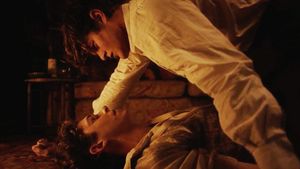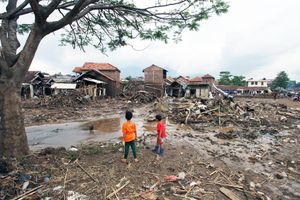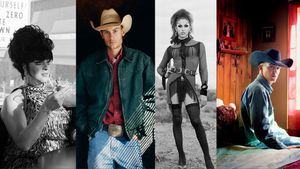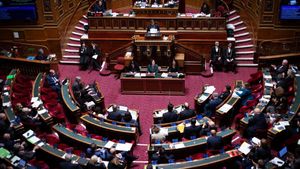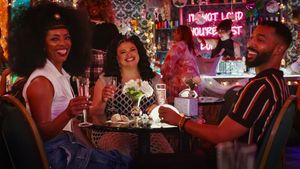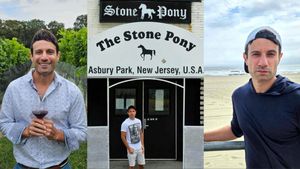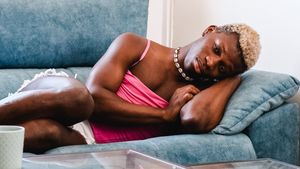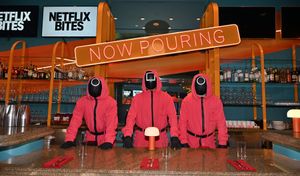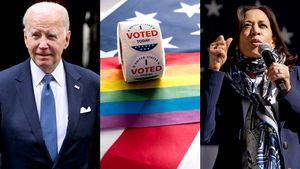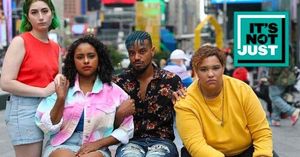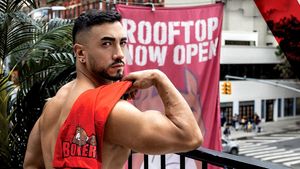When the
internationally famous pop artist Keith Haring died of
AIDS-related complications in 1990, he left behind a
complicated legacy of collaborative work with street
artists, graffiti-inspired murals, world-renowned
homoerotic icons that straddle the line between art
and commerce, and a multimillion-dollar foundation that
would promote his work. He also left his partner of
his later years, Juan Rivera, with whom he lived until
shortly before his death, out of his will. Rivera had
arrived in New York from a poor inner-city Connecticut
neighborhood toward the end of the 1970s as a runaway.
After Haring's death, Rivera would return to a
small apartment in Spanish Harlem, where he now lives,
struggling to survive and keep his HIV status in check.
In his most
recent book, Queer Latino Testimonio, Keith Haring,
and Juanito Xtravaganza: Hard Tails (Palgrave 2007),
Fordham University professor Arnaldo Cruz-Malave
revisits their relationship as a metaphor for the
turbulent and complex 1980s. Hard Tails is a
mold-breaking testimonial of the life and times of
Juanito (Xtravaganza) Rivera.
I first met
Professor Cruz-Malave in June 2008 at a bilingual
reading for Los Otros Cuerpos, the first
anthology of queer Puerto Rican writing, organized at
the Clemente Soto-Velez Cultural Center in
Manhattan's Lower East Side, and was awed by the
power of his word. When I read Hard Tails, I
was entranced by its revolutionary character,
organization, and ability to capture what I had so
vividly witnessed as a Cuban-Puerto Rican kid growing
up in the Bronx: the evolution of hip-hop from an
inner-city, war-zone cultural expression to a global
force. I sat down with Cruz-Malave at a Colombian
restaurant in Jackson Heights, Queens, where he lives with
his spouse, dancer Greg de Silva. Over hearty bowls of
Colombian sancocho we discussed his exceptional
Hard Tails.
Advocate.com:HardTailsillustrates the joys and dilemmas of Juanito
(Xtravaganza) Rivera in an unorthodox yet
fascinating format. Could Juanito's story have
been written as a traditional biography, or would
that have been too limiting?Arnaldo Cruz-Malave:Hard Tails is a book that grew organically out
of my relationship with Juan Rivera, the Juanito
Xtravanganza of the title, though I reflected long and
hard about the book's structure and think now
that it is one of its most important accomplishments. I
could have written it as a biography, as some
publishers wanted me to do, but it would have
flattened out the book's dialogic character -- that
is, not only the dialogue between Juan and me, or
between Juan's and Keith Haring's lives,
but also the dialogue among the multiple voices and
genres contained in the book.
Hard Tails is a sort of queer testimonio, the
well-known Latin American testimonial novel or memoir, which
became so popular and almost canonical in American
colleges throughout the 1990s, or a queering of
testimonio as a genre. In conventional testimonio, you
know, the author or "editor" erases the traces
of the multiple interviews with a socially
marginalized character that produced the text in order to
give the impression that one is, as it were, seamlessly
peering into a life and world one would never have
access to by reducing all dialogue to a first-person
account. With Hard Tails I wanted to do the
opposite. I wanted the reader to be self-consciously
aware of the text's production, to engage with it, to
stop and listen before rushing to judgment, to
interpret and reconstruct, not merely as an
experimental flourish but as an ethical act, as a way of
giving back.
You come across as "the chosen one" to write and
organize this testimonial, since you're alive and
breathing in the text, you're part of the
story. Would you have written this book had you
not met Juanito Rivera before he moved to New York City
and met Keith Haring? Had I met Juan at any point and had he trusted
me enough to confide in me his tale or tales of
arriving in New York City at a time when the city and
especially its Latino and minority neighborhoods were
undergoing a contradictory and brutal process of
gentrification, I would have found his story
compelling and poignant enough to feel that someone, if not
me, should write it down. Juan would eventually meet
1980s pop icon Keith Haring at the Paradise Garage,
that legendary underground disco where black and
Latino gay youth, vogueing drag queen divas, and homeless
kids sweated and swirled with music business insiders
and up-and-coming media celebrities, and that part of
his story, his relationship with Haring, also seemed
compelling to me. It seemed to shed so much unconventional
light on the desiring, conflicted, complicated, and
downright messy relationship or romance between
popular street culture and high art during the 1980s.
In addition, Juan's story spoke movingly to me as a
migrant, a gay Puerto Rican migrant, for yes, as you say, I
am also part of the tale. It was fortuitous to have
met Juan before he moved to New York, and that
established a bond of trust between us that would allow me
to enter his life. But what would truly compel me to listen
to Juan's story first and then write it down
was his voice, a sort of ethical command in his voice.
You discuss how mid-20th-century TV and cinema
perpetuated Puerto Ricans as erotic objects to the
mainstream "white" eye. When Keith
Haring moved to New York City, he discovered an infinite
landscape of dark boys, alongside hip-hop and graffiti
-- his admitted obsessions. What do you suspect
Juanito possessed (other than his obvious beauty)
that compelled Haring to keep him by his side longer
than his other lovers, even though he was omitted
from the will? It is true that I discuss the sexualization of
Puerto Ricans in New York City. But I also point to
the traps that responding to that sexualization hold
for Puerto Rican and Latino authors who feel the pressure to
confront it by presenting themselves as fully scrubbed
"decent" "representative"
ethnic subjects. It is about the entangled, complicated
relationships of desire across race and class that we are
all inextricably implicated in. Interestingly enough,
in his interviews Juan resists seeing himself as a
victim. Instead, he prefers to spin more and more
complicated tales that leave some room for maneuver. That
said, there is no doubt that Haring had a voracious
appetite for difference, for otherness, and an
insatiable -- almost blinding -- need to see himself
precisely in that different other's validating eyes.
This is quite evident in Haring's posthumously
published Journals where Juan appears first as one of
those special people in whose eyes Haring is able to
recognize and see his own difference. But as their
relationship develops and Juan becomes more demanding
about being more than a mirror for Haring's
difference, about being seen, their relationship begins to
falter, and Haring will search elsewhere to regain that
initial look of recognition across differences that
fueled his art.
Haring thrived amidst the gay avant-garde East
Village underground 1980s art scene that you chronicle
vividly in the book, but he also went on to become
a very wealthy, international pop art icon. Had
this already happened when Juanito met him? By the time Haring and Juan met in 1986 Haring
was internationally famous. He had managed to
transform his street, graffiti-inspired, cutting-edge
art into both gallery art and media-and-market phenomenon.
Especially in Japan, where he was treated with all the
fanfare of a rock star, his art would be endlessly
copied and commodified. And his Pop Shop in New York
and Tokyo, which some have seen as a sign of his
capitulation to commerce, may be seen in this light
instead as his frustrating attempts to control that
increasing commodification. In my book, I am in no way
proposing that Haring owes his career to Juan, although Juan
was very supportive of him during this crucial period
in his life. However it is clear that Haring, like so
many other great artists, was not some independent
genius whose artistic project existed in his mind as in a
kernel from his childhood in Kutztown, Penn., as some have
proposed. The brilliance of Haring's art is a
testament to his intense dialogue with the popular
cultures of New York, and his limitations are as well a
reflection of the conflicts and limitations of that
long-standing dialogue between high art and popular
cultures. For all art, as Haring himself knew, is
dialogue, conversation.
The theme of the queer individual's migration to
reinvent his identity resurfaces throughout the text. I
left New York City in 1988 for the West Coast for
this exact rite of passage. You, Keith, and
Juanito all left your places of birth and youth to come
to New York City, to move in directions that your
respective origins could not offer or even
tolerate. Can you elaborate some more on this? That is to me a very moving and personal aspect
of the book. But, you know, there isn't a
single story of gay self-fashioning through migration,
as it is supposed. Not all queers migrate from small towns
to end up in an enlightened gay village, Castro, or
Chelsea. Queer migrations are also intersected by
class, race, and ethnic belonging. My book, as I said
before, is, among other things, about the intersection of
three queer migrations, realized with different expectations
and under different degrees of duress: Haring's
from a small-town, middle-class environment in
Pennsylvania Dutch country; Juan's from a poor
working-class inner-city immigrant neighborhood in New
Haven, Conn.; and mine from a small agricultural town
undergoing modernization in Puerto Rico's
interior, a town with the improbably gay name of San
Sebastian del Pepino -- oh yes, St. Sebastian of
the Cucumber. That we could intersect at all, despite
our differences, seems stunning and very moving to me,
not so much a reflection of our shared commonality as of the
utopias that can still be summoned by the sign of
"queerness."
Part of the reason you wanted to write the book, as
you explain in the introduction, was to give a voice to
Juanito Rivera, who was cut out of Haring's
estate. Would there have been a book to write had
he not been cheated? Yes. Although the book is clear and forthright
about Juan's claim, it is also more than that.
It is a book, as I've said, about the complicated,
entangled, desiring, messy relationship between Latino
street culture and high art; a history of New
York's Latino neighborhoods during a period of
devastating state disinvestment and gentrification, the
1980s; and a meditation on the art of listening and
the ethical limits of representing queer Latino lives.
It is also an AIDS memoir and an unapologetic work of
mourning for all those who have disappeared, or were made to
disappear, in order to create the more mainstream,
contemporary New York we all inhabit. It is a
celebration of sorts of the small, tenuous, everyday
acts of survival of people like Juan, a small tribute to the
complexity and beauty of their lives.
Despite Juanito's being accused of leaching onto
Haring's fortune, he helped Haring stretch
canvasses, accompanied him around the world,
filled in murals, drove, cooked, and took care of him
while he was dying. By Juan's and Haring's own
accounts in his journals, Juan very actively assisted
and supported Haring doing all the things that you mention,
from stretching canvasses to filling in murals, from
driving to cooking, during the time that they were
together from 1986 to briefly before Haring's
death in 1990. And in addition Juan has a fascinating
personality and is an engaging storyteller, with a haunting
voice, as I have tried to capture in his interviews in
the book.
So what does Juanito think of the book? He feels very proud about the way his life and
stories have been captured. You know, I was compelled
to write the book when Juan walked back into my life
after almost 20 years from first meeting him in New
Haven and handed me a book he could barely read, John
Gruen's Keith Haring: The Authorized
Biography, where his name appeared besmirched. So
I wanted to get his story right, to tell it as a
tribute, a small tribute to the creativity and beauty of
lives like Juan's, but I also wanted to tell a
complex story, not an airbrushed or heroic one. I had
read drafts of the book to Juan many times, but I was
still very nervous when Juan's friends from the New
York ballroom scene and his family from New Haven, his
mother, his sisters, and even his little nephews and
nieces, showed up to the book's launch at Barnes
& Noble last fall. It was a packed house with ballroom
children and HIV activists, Latin American and Latino
academics, critics, writers, and family. And at the
end of the reading, Juan's sister, a pretty and
elegant woman, stood up and proceeded to thank me in very
eloquent and moving words on behalf of her family. At
that moment Juan's face seemed to glow and I
felt like I was floating, like a weight had been finally
lifted.









